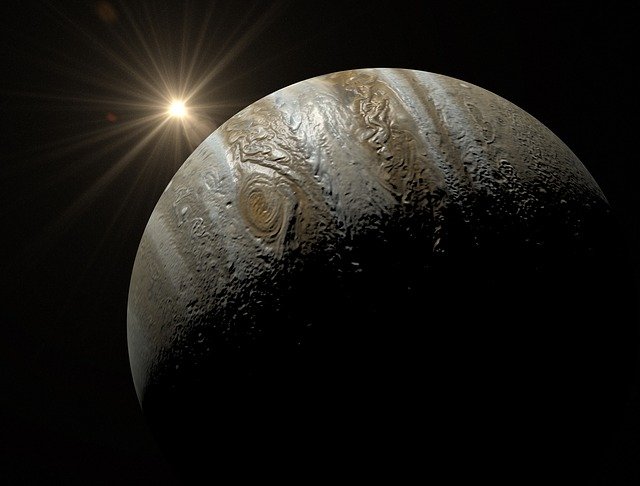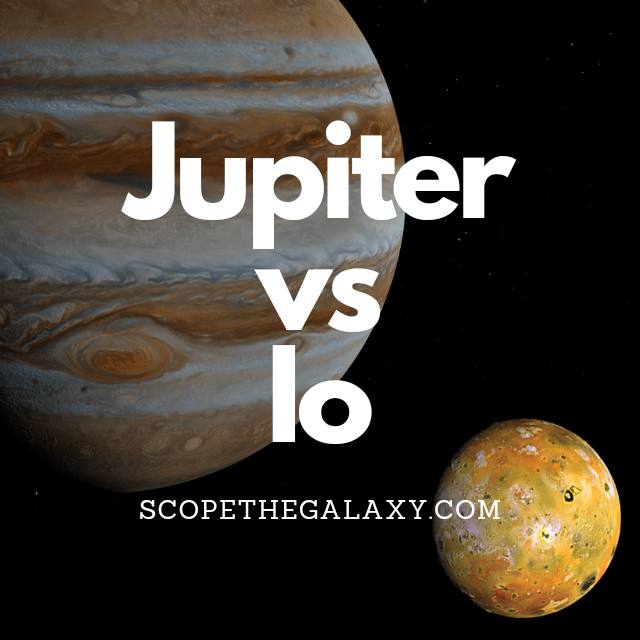*This post may contain affiliate links. This means we may make a commission if you purchase an item using one of our links*
The main differences between Jupiter and Io are that Jupiter is the largest planet in the solar system with a diameter of 139,820km whilst Io is the 4th largest moon with a diameter of 3,643km, Jupiter has 79 moons orbiting it whilst Io has 0 other moons orbiting it, Io is amongst the most volcanically active entities in the solar system whilst Jupiter has the most powerful magnetic field in the solar system.
There are various other differences between the two so, continue reading for a more detailed look at each of these celestial bodies along with their similarities and differences below.
What Is The Planet Jupiter?
Table of Contents

Jupiter is the 5th farthest planet from the Sun and the largest planet within our local solar system. The planets most recognizable trait is the giant red spot visible on its atmosphere along with the brown horizontal bands flowing across its atmosphere.
As a result of its composition and size, Jupiter falls under the classification of a gas giant.
This is because its composition mostly consists of the elements hydrogen and helium. The split is roughly 71% hydrogen, 27% helium, with the remainder of the elements split throughout the left over 2%.
As the biggest planet in our solar system, Jupiter is 139,820 km or 1,300 Earths in diameter, it has a mass of around 0.001 solar masses, the temperature when inside the clouds are roughly -145 degrees Celsius whilst the core is far hotter, equating in the region of 24,000 degrees Celsius.
Due to its extreme circumstances, gaseous composition and distance from the Sun, the planet is not theoretically capable to support life, from its subzero temperature to the extremely fast 640 km/h winds, and its gravity which may be unsustainable for our bones, roughly 2.4 times greater than Earth’s.
Although the conditions on Jupiter aren’t suitable for us, some of its 79 moons like Europa for example could support life.
This brown giant has a relatively fast rotation around its axis where 1 rotation typically takes 10 hours to make whilst its orbit around the Sun is far longer taking in the region of 12 years for 1 full cycle.
Another feature of Jupiter that is renowned by astronomers is the strength of its magnetic field. In comparison to the other planets in our solar system it is even stronger than our Sun, where it’s over magnetosphere is roughly 20,000 times the strength of Earth.
What this means is that Jupiter’s magnetosphere is able to avert solar winds that are 3 million kilometers away from it.
What Is The Moon Io?

The Moon Io – also known as Jupiter I – is the third largest of the Galilean moons, which has the closest orbit to Jupiter. It is the fourth-largest moon in our solar system by size – with a diameter of 3,643km – but has the highest density of all moons in the Milky Way.
In addition, Io has the strongest surface gravity of all moons and the least water by atomic ratio compared to any other astronomical object in our solar system.
Perhaps the most interesting feature of this lunar body is the 400 active volcanoes on its surface, which make it the most volcanically active object in the Milky Way; some of these volcanoes can exude plumes of sulfur to a height of several hundred miles.
The reason for this intense activity is the tidal heating caused by friction in the moon’s interior. Thanks to Io’s proximity to Jupiter, it finds itself caught between the gravity of its planet plus the two nearby moons – Ganymede and Europa. And this creates extreme tidal forces.
A side effect of these tidal forces is heat, which keeps most of Io’s crust in liquid form. Because of this, the surface of Io experiences a constant state of renewal; sites once home to large craters are slowly filled with molten lava and liquid rock.
While the complete makeup of Io’s surface is not yet defined, theories suggest that its main component could be sulfur and sulfur compounds because of the varied coloring. Silicate rock could also be a likely component as it would account for the high temperatures.
Io orbits Jupiter from a distance of around 422,000km, with an orbit that takes 42.5 hours to complete. Sitting 778,000,000km from the Sun, the surface temperature of this planet sits around -130 degrees Celsius. But due to the intense volcanic activity, the lava flows can reach temperatures of 1649 degrees Celsius, which is far hotter than anything on Earth.
Similarities Between Jupiter And Io
There are a few similarities that Jupiter and Io share, which in this case includes the following:
- Both are a spherical shape.
- Both have a hotter core.
- Both are part of the same solar system.
- Neither have tectonic plates.
- Both orbit another object.
- Both orbit the Sun in 12 years.
Differences Between Jupiter And Io
As for the differences between the two, they include the below:
- Io is volcanically active whilst Jupiter being a gas giant means it is not.
- Jupiter is a gas giant whilst Io is a terrestrial based moon that orbits Jupiter.
- Jupiter has 79 moons orbiting it whilst Io has 0.
- Jupiter is composed of mostly hydrogen and helium whereas Io has a thin atmosphere composed primarily of sulfur dioxide.
- Jupiter has the strongest magnetosphere in our solar system, whilst Io does not have a magnetic field surrounding it.
- Jupiter is far bigger with a diameter of 139,820km compared to Io’s 3,643km.
- Jupiter’s density is 1.33 g/cm³ whilst Io’s is 3.53 g/cm³.
- A day on Jupiter is 10 hours whilst a day on Io is around 42 – 43 hours.
- Io is tidally locked to Jupiter whilst Jupiter is not tidally locked to anything.
- Jupiter orbits the Sun in a nearly circular pattern whilst Io orbits Jupiter elliptically.
- Io’s gravitational strength is 1.796 m/s² whilst Jupiter’s is 24.79 m/s².
- In regards to mass, Jupiter’s is 1.898 × 10^27 kg whilst Io’s is 8.93 × 10^22 kg.
- Jupiter’s temperature is -145 degrees Celsius on average whilst Io’s is around -130 degrees Celsius.
Summary
Although Io is one of Jupiter’s Galilean moons and as a result they both inhabit the same local region, the two are ultimately physically and compositionally very different from one another.
Whether it be in regards mass, size, the number of objects that orbit them, the activity on their surfaces and beyond, these two are very much distinct entities and operate very uniquely as a whole.

